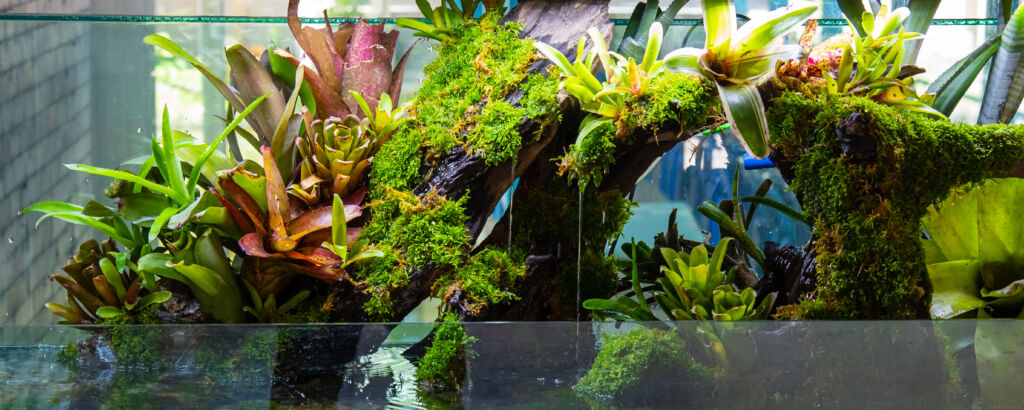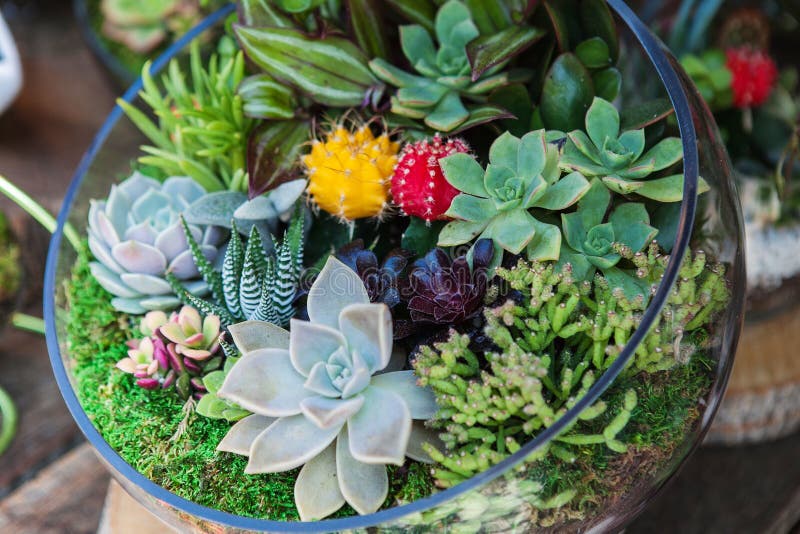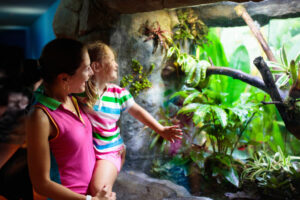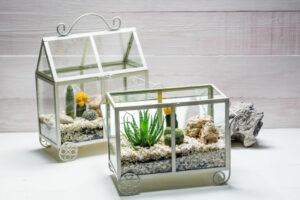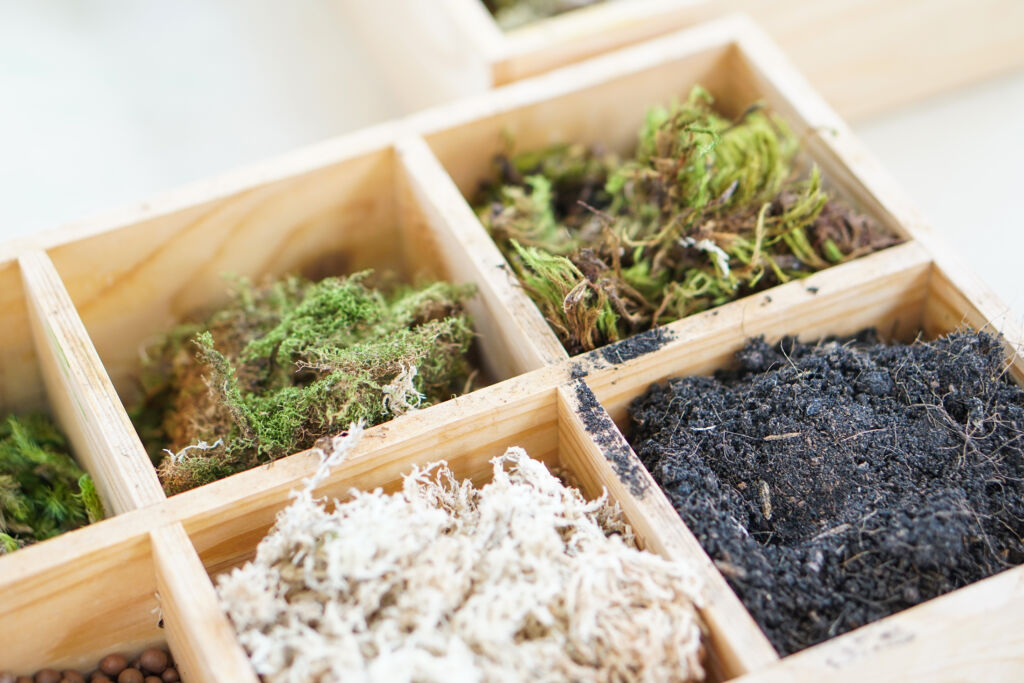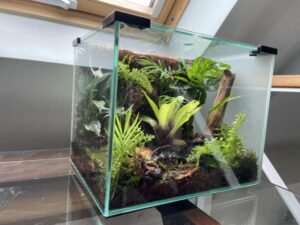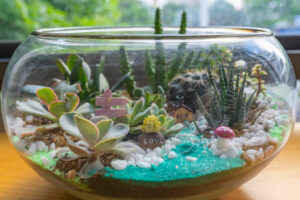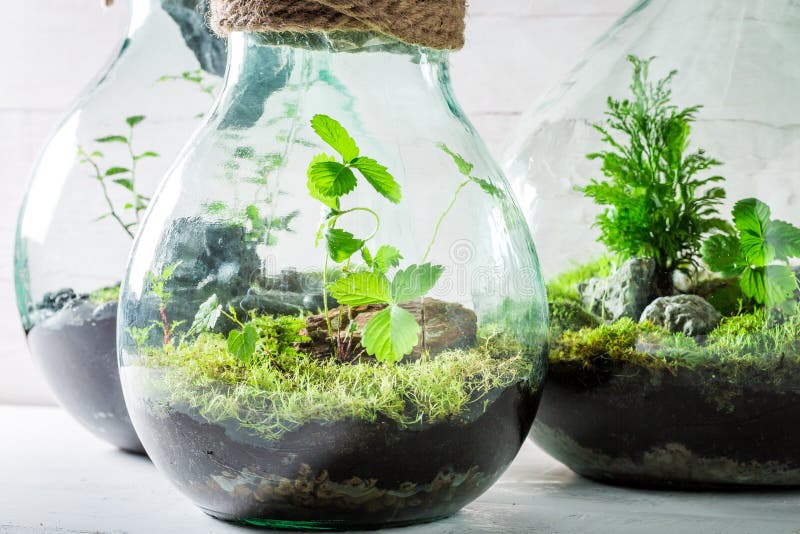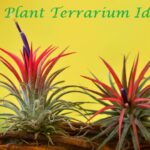HousePlantJoy is supported by our audience. When you purchase through one of our links, we may earn a small affiliate commission. As an Amazon Associate I earn from qualifying purchases. Your cost is not affected.
==================
Set Up a Terrarium in 7 Easy Steps
Have you ever experienced coming home so tired, then catching a glimpse of your favorite orchid, and instantly feeling wonderful? That’s the power exotic plants and a piece of Nature could do, like in a terrarium filled with beautiful plants. It’s a glass-enclosed, miniature garden with plants, cacti, succulents, sand, and pebbles. Interested? Stick around and we’ll show you how to set up a terrarium.
So, whether you live in an apartment, a townhouse, or a bungalow with a garden, a terrarium would be a pleasing addition to your decorative plant collection. Though you can’t compare, or replace a garden, with a terrarium, you can have both, right? The advantage is that you have a piece of nature in your home that you can display anywhere you like. And building a terrarium yourself is the first step to creating bigger, better, and more complex ones.
Aquarium, Terrarium, and Vivarium
Everybody knows that an aquarium is basically a glass tank filled with water to exhibit aquatic plants and animals such as different, colorful species of fish. There are many variations of it like a big one built into a wall making it the focal point. In contrast, the terrarium is a container that displays interesting flora. The vivarium is more like a terrarium but it includes small live animals such as frogs, lizards, and turtles, to name a few. It is created to mimic the natural habitats of animals. That includes the jungle, the rainforest, and the savanna.
Setting up your first terrarium
Let’s make something clear. A terrarium is not a replacement for a garden. You may have or not have a garden and still have one or several terrariums. A garden is a feature of a property, a part of the yard. While a terrarium is displayed, or showcased, inside the house. Most people would want to personalize things they own, and the terrarium is one of them.
For a DYI (do-it-yourself) enthusiast and even someone who isn’t, setting up a terrarium could be easy. If you leave it to someone skilled at it, that would be better. Know that the terrarium container could simply be using an existing glass container with a lid.
The range of alternatives goes all the way up to big terrariums. They’re placed on a display table, a sideboard, a display niche on the wall, or even on a table in the middle of a spacious room. For most people, one big, hard-to-miss terrarium would be preferred over a collection of smaller bottles or jars. Just imagine how many plants it can hold, and its awesome impact on your living space.
Get Acquainted with the 5 Components or Layers of a Terrarium
You might want to try building a terrarium yourself. It’s like taking baby steps. You won’t have to spend money by using what’s available. But if you don’t, it won’t cost a lot to buy the things needed. But first, you need to know the different layers that make up a terrarium. Some are essential and the others you may leave out. We’ll start with the bottom layer up to the top.
Drainage Layer:
The excess water goes down here to evaporate naturally. This layer helps in making the upper substrates, or layers, not soggy as over-watering would be bad for the plants.
Soil Layer:
Soil contains nutrients that plants need to grow and flourish. This is where the plants (vegetation) get the nutrients through their roots. And the roots also anchor the plant to the soil for stability.
Man-Made Features Layer:
It’s also called “hardscape” in Landscape Architecture as opposed to softscape or landscape, which includes the flowers, plants, trees, grass, and all other live components. Examples in this layer are stones, rocks, pots, and figurines. Depending on the size of the container, this may be left out or it could be over-decorated.
Plant Layer:
This is the layer that’s being showcased. A few of the best bets are small plants such as tropical plants, ferns, mosses, cacti, and succulents.
Ornamental Layer:
It may include decorative pieces like small figurines or a water feature like a mini-waterfall or a cascade. This layer can be changed once in a while if you have several other items that are worth including. If you’re a minimalist, this layer can be skipped entirely, or done in a minimalist way.
Now you know the 5 layers of a terrarium. It’s time to roll up your sleeves and summon up your creativity. Allow your ideas to guide you with the step-by-step instructions in setting up your own terrarium.
How to Set Up a Terrarium: A No-Nonsense Step-by-Step Guide
Creating a terrarium is an interesting and straightforward, quite easy-to-follow process. First, visualize in your mind’s eye what your ideal terrarium looks like. Remember it, and write the details and description and save it on your laptop or mobile phone. Decide what its size should be with the plants you’d like to include.
Choose plants that grow in low to medium light intensity. You’d like your first terrarium to look attractive, so choose them carefully and make sure there is variety in their overall shape, leaf size and shape, color, and texture. These will give you ideas on how to arrange them inside the glass enclosure.
As some terrarium plants thrive in a humid environment and others don’t, it’s better to have a lid so you can occasionally take it off. For instance, cactus and succulents do not do well in enclosed terrariums. But they’re beautiful and mixing them with other plants creates pleasing contrast. So, choose varieties that can tolerate a closed terrarium environment.
1. Install Clear Glass Container:
Get a tempered, shatter-proof, or laminated glass container for safety, and with no drainage holes. Look for the size and shape that you want to hold all the materials to be used. They’re the plants, soil, rocks, pebbles, and small decorative pieces. You may also include the small amphibian animal you like, like a frog or a small turtle.
Buy one from a store that specializes in aquariums and terrariums. If you prefer a custom-built terrarium, ask if they can build one. Otherwise, look for a store that has that service. Lastly, if you’re an advanced DIY aficionado, you can make one yourself. Be sure to use laminated glass or tempered glass. They don’t easily break.
2. Put Pebbles, Small Rocks, and Sand:
The base or bottom of the terrarium must be lined with aquarium gravel, pebbles, a few crushed rocks bigger than the pebbles. They serve as the water drainage and hold the excess water that will cause rotting in the plants. This layer must at least be 2 inches.
3. Add a Layer of Sheet Moss:
Cover the pebbles, rocks, and sand with a layer of sheet moss as an added protection against potting soil trickling down into the bottom layer.
4. Add Activated Charcoal:
A thin layer of activated charcoal is a must to keep the water fresh and prevent bacterial growth.
5. Add Potting Soil:
Next, add potting soil using a small trowel over the previous layer. And as terrarium plants don’t need fertilizer, make sure the potting soil doesn’t contain fertilizer.
6. Prepare the Plant:
This step requires aesthetic vision and must have been conceptualized at the start. So, the actual design of the terrarium could be more developed at this point. The strategic and well-thought-out ideas on where to place each plant material are already identified. Such as the placement of tall and short plants, the contour of the soil, to name a few. Also cutting off rotting or damaged leaves, washing and cleaning them must be done regularly.
7. Place the Plants:
Dig a hole in the soil for each plant. Remove unwanted soil clinging to the roots. Then place each plant into its designated hole. Finish off by patting down on the soil to release air pockets and to stabilize the plants’ placement. Congratulations! You’ve just set up a terrarium!
8 Common Terrarium Mistakes to Avoid
You may want to set up a terrarium for yourself. Embarking on such a project is not that difficult. It could even be fun and would give you an exhilarating feeling of accomplishment. And so, it’s time to learn some common mistakes in caring for them and how to avoid them.
01 Excessive Light
Most terrarium plants don’t need strong light. So, don’t place them under direct sunlight or bright lighting. If you do, there’s the risk of burning them. Keeping your terrarium away from direct sunlight is easy to do as it’s inside the house. So, place them away from south-facing windows where the strongest sunlight shines through.
02 Deficient Light:
Some types of terrarium plants, however, do need some light to thrive. Place them where they get enough indirect sunlight. If that’s not possible, you may use growth or fluorescent lamps.
03 Leggy and Overgrown Plants:
The cause is the plant being in a spot where it’s too far from sunlight. Then it has to grow in length to reach the sunlight but at the cost of losing its bulk or width. It results in a disproportionate longer length to its width. And it tends to bend over because its stem can’t support the weight. So, it becomes unnaturally long or “leggy.”.
04 Dying Plants:
If you notice signs of a plant dying, take it out of the terrarium immediately. It can affect and spread to other plants around it. Remove the plant carefully using a small tong, chopstick, or a small shovel.
05 Terrarium Glass That Needs Cleaning:
Promptly clean dirty terrarium glass enclosure, in and out, so the stream of sunlight reaches the plants. Clean both sides of the glass and don’t use cleaning products that contain harmful ingredients. Instead, use organic vinegar with a microfiber cloth. A microfiber cleaning cloth catches tiny dirt that could potentially scratch the glass surface. After cleaning, be sure to wash the microfiber cloth to get rid of the captured dirt and grime.
06 Overwatering the Terrarium Plants:
Use a spray bottle instead to prevent over-watering. If you have over-watered them, use a microfiber cloth to soak up water, and leave the terrarium open until the water dries out.
07 Excessive Fertilization:
Generally, terrarium plants don’t need fertilizers at all because they contain ingredients that may harm them.
8 Choosing the Wrong Plants:
There are already plants recommended for a terrarium environment, so choose from among these plants. For a lidded terrarium, choose plants that thrive in a moist environment. For an open terrarium, a desert-inspired environment would grow well in this warm and dry terrarium. Cacti and succulents need little moisture and they look great.
Conclusion:
Both in our home and the workplace, plants are nice to have as they give off oxygen and they’re fascinating to behold. When you set up a terrarium, you provide an additional layer of connection with nature. And learning how to make one yourself is an empowering experience. Creating a terrarium can lead to a journey of discovering the intriguing world of plants and flowers.
Here’s hoping that the steps shared in this post will help you set up your terrarium successfully. If you have questions or suggestions about the topic, don’t hesitate to post them below.
Q: What is the advantage of adding stones and pebbles in a terrarium?
Ans: When you assemble a terrarium, the layer of stones and pebbles serves as the drainage for the excess water in the soil. It keeps away the water from the roots and plant to prevent over-watering which leads to decay and rotting.
Q: Why should I add charcoal while setting up a terrarium?
Ans: A layer of activated charcoal is helpful to keep the water fresh and prevent bacterial growth. That’s because charcoal also eliminates toxins and odors
Q: What is the average lifespan of a terrarium?
The lifespan of a terrarium depends not on just a single plant. The glass enclosure, the different layers, the person taking care of it, and other factors can affect it. So, Provide the right conditions and care for them, and they could bring you joy for about ten years.
READ MORE:
https://houseplantjoy-temp.siterubix.com/13-cactus-houseplant-types-to-you-can-grow-indoors/
https://houseplantjoy-temp.siterubix.com/growing-a-new-hobby-with-houseplants/
https://houseplantjoy-temp.siterubix.com/bamboo-as-a-houseplant/
Beautiful Houseplants That Repel Bugs and Other Pests
10 Low-Care Plants That Grow Well in Terrariums

